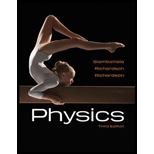
Concept explainers
(a)
Find the period of the pendulum for each horizontal axis.
(a)
Answer to Problem 103P
The period of the pendulum for each horizontal axis is
Explanation of Solution
Write the equation for time period of the physical pendulum.
Here,
Write the equation of the moment of inertia for uniform rod.
Here,
Conclusion:
Substitute equation (II) in equation (I) and replace
Substitute
Therefore, the time period of the pendulum for each horizontal axis is
(b)
Find the period of the pendulum for two rods.
(b)
Answer to Problem 103P
The time period of the pendulum for two rods is
Explanation of Solution
Consider the meter stick as two rods with lengths
Write the equation of the moment of inertia for
Here,
Write the equation of the moment of inertia for
Rewrite the equation (III).
Rewrite the equation (IV)
The total inertia of the two rods is.
Conclusion:
Substitute
Substitute
Therefore, the time period of the pendulum for two rods is
(c)
Find the period of the pendulum for two rods.
(c)
Answer to Problem 103P
The time period of the pendulum for two rods is
Explanation of Solution
Consider the meter stick as two rods with lengths
Write the equation of the moment of inertia for
Write the equation of the moment of inertia for
Rewrite the equation (V).
Rewrite the equation (VI)
The total inertia of the two rods is.
Conclusion:
Substitute
Substitute
Therefore, the time period of the pendulum for two rods is
Want to see more full solutions like this?
Chapter 10 Solutions
Physics - With Connect Access
 College PhysicsPhysicsISBN:9781305952300Author:Raymond A. Serway, Chris VuillePublisher:Cengage Learning
College PhysicsPhysicsISBN:9781305952300Author:Raymond A. Serway, Chris VuillePublisher:Cengage Learning University Physics (14th Edition)PhysicsISBN:9780133969290Author:Hugh D. Young, Roger A. FreedmanPublisher:PEARSON
University Physics (14th Edition)PhysicsISBN:9780133969290Author:Hugh D. Young, Roger A. FreedmanPublisher:PEARSON Introduction To Quantum MechanicsPhysicsISBN:9781107189638Author:Griffiths, David J., Schroeter, Darrell F.Publisher:Cambridge University Press
Introduction To Quantum MechanicsPhysicsISBN:9781107189638Author:Griffiths, David J., Schroeter, Darrell F.Publisher:Cambridge University Press Physics for Scientists and EngineersPhysicsISBN:9781337553278Author:Raymond A. Serway, John W. JewettPublisher:Cengage Learning
Physics for Scientists and EngineersPhysicsISBN:9781337553278Author:Raymond A. Serway, John W. JewettPublisher:Cengage Learning Lecture- Tutorials for Introductory AstronomyPhysicsISBN:9780321820464Author:Edward E. Prather, Tim P. Slater, Jeff P. Adams, Gina BrissendenPublisher:Addison-Wesley
Lecture- Tutorials for Introductory AstronomyPhysicsISBN:9780321820464Author:Edward E. Prather, Tim P. Slater, Jeff P. Adams, Gina BrissendenPublisher:Addison-Wesley College Physics: A Strategic Approach (4th Editio...PhysicsISBN:9780134609034Author:Randall D. Knight (Professor Emeritus), Brian Jones, Stuart FieldPublisher:PEARSON
College Physics: A Strategic Approach (4th Editio...PhysicsISBN:9780134609034Author:Randall D. Knight (Professor Emeritus), Brian Jones, Stuart FieldPublisher:PEARSON





